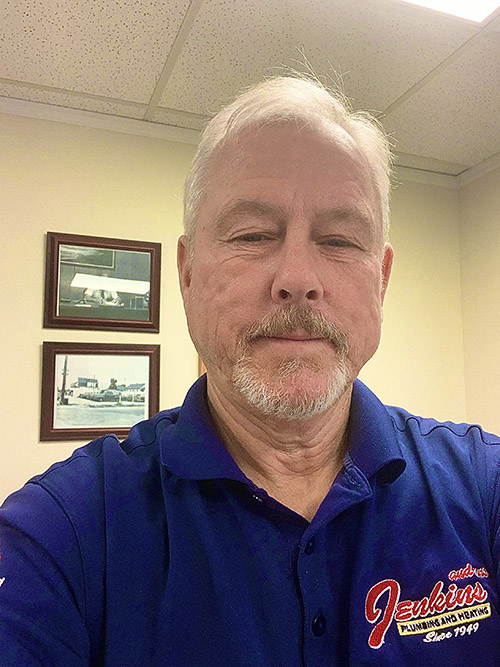By James FitzPatrick
Contributing Writer
It’s expected to be 40 degrees when the Eagles and the Giants kick off their playoff game 8:15 p.m. Saturday at Lincoln Financial Field.
The players will face many challenges as they take on their division rivals. But thanks to an invention that debuted in Ocean City and was perfected by a plumber from Absecon, the cold won’t be one of them.
Heated benches are standard equipment on all NFL sidelines in games where cold weather is a factor. But nearly 50 years ago, they were just an idea.
It was 1974 and John Jenkins was looking for a way to provide comfort to his son’s Pleasantville High School football team during a Thanksgiving game in Ocean City. The forecast called for unusually cold weather.
Jenkins, the owner of Jenkins Plumbing in Pleasantville, got an idea. What if the benches were heated?
He got busy, nailing some 2-by-12s together to make a bench and attaching sides to create an enclosed space. Next, he added a portable heater to create his first heated sideline bench. The players liked it and so did the coaches.
Pleased with his initial success, he refined his idea into a fiberglass bench that used ducts, vents and a combustion heater to warm the space beneath and seating areas. He applied for a patent in 1974 and it was granted in 1976. The Jenkins’ Hot Seat was born.

He perfected his design, testing variants with help from the Pleasantville High School football team and an Egg Harbor City manufacturer that fabricated the fiberglass benches in sections, minus the inner workings.
Jeff Jenkins, 67 of Absecon, was with his dad every step of the way as the Hot Seat grew from an idea to an NFL mainstay and a thriving business. They got their big break in 1978 when they took the benches to Veterans Stadium for a Philadelphia Eagles tryout.
The Eagles liked what they saw. Soon they were hired to operate the seats on a lease-purchase basis for every home game. The Giants and the Jets soon followed.
As business grew, teams would either buy the benches or rent them. They sold benches to cold-weather locations, including Buffalo, Cleveland, Cincinnati, New England and Green Bay.
When cold weather set in they rented them on a per-game basis to teams that didn’t have them. For playoff games they worked with the NFL directly, which wanted to be sure that both sidelines were covered.
“Every Monday morning I would get on the phone and talk to various teams after looking at the weather reports where the cold weather was going to be,” Jeff Jenkins said. “Then I would contact the teams that were playing and if they didn’t have equipment, we would bring them in.”
It was a lot of work transporting, setting up and breaking down the benches. The kerosene-fired heaters had to be monitored to maintain safety. If they got too hot or players stood too close, they could cause the players’ synthetic uniforms to melt.
“I’ve seen people get burned,” he said. “There’s a lot of nylon and plastics in the equipment for stretchability. They just melt if they get too close to them.”
Jenkins believes the Hot Seats and the Eagles were instrumental in the establishment of the NFL’s equity rule, which requires home teams to give visiting teams equal access to resources and accommodations.
Before the rule, equal treatment was assumed by gentleman’s agreement. Jenkins said that changed because of an incident at Veterans Stadium involving the Hot Seats and Eagles head coach Dick Vermeil.
“The benches were set up on the sideline, but only the Eagles’ side,” Jenkins said.
During the pregame, a coach from the other team commented on how nice the benches were. There were four benches and the visitors asked to move two to the other side. Vermeil said no. The next year the equity rule was enacted.
Jenkins said he and his father handled all of the bench business.
“I did all of the traveling. My father was a little bit older then so he did all of the Eagles, Jets and the Giants and the closer games with the crews,” Jenkins said.
The crews were mostly friends who were happy to help in exchange for being on the sidelines at an NFL game. Each crew required four people: two on each sideline, always an experienced person paired with a less experienced one.
Each bench section was made of two 12-foot segments, with each segment weighing about 200 pounds. Each sideline had two 24-foot sections. Each four-person crew tended to four heaters – two on each sideline.
Jeff Jenkins had memorable encounters with Hall of Famers including Jim Brown, who signed a football for him; Deion Sanders, who gave him his wristbands, and Jim Kelly, who shared a White House sub with him.
He moved quickly from being an NFL fan to a man doing a demanding job. The effort and time required kept him away from his family. He was gone most weekends during football season.
“I can remember Christmas morning getting home at 5 or 6 o’clock in the morning, driving all night from somewhere like Cleveland to get back for Christmas,” he said. He did a lot of driving straight through from distant places like Denver and Dallas to be at the plumbing business by Monday.
“It was a lot of time on the road, and a lot of time standing in the cold,” he said.
They had a game that was colder than the infamous Ice Bowl, the 1967 NFL Championship game between the Green Bay Packers and the Dallas Cowboys that holds the official record as the coldest game of all time. That game was -13 degrees.
“In 1983 and we did a game in Cincinnati. It was a playoff game between Cincinnati and San Diego,” he said. “The actual chill factor was like 54 below. The actual temperature was about 35 below. It was the coldest place I’ve ever been.”
Jeff Jenkins said the Hot Seat was an extension of the kind of person his father was.
“He was always kind of an inventor. He was always coming up with ideas, different things in the trade and different things that he thought about,” he said. “He was always a problem solver. We still do this today.
“For him to come up with this and put in the effort and time in patenting and building and designing all this for an idea that he came up with when I was playing ball I thought was pretty incredible.”
Jeff Jenkins, who carries on the family business at Jenkins Plumbing and Heating, said the lessons his father taught him have served him well.
“Like my father said, ‘I’m never going to leave you a lot of money, but you will always be able to make a living with the education you’ve gotten here at the business.’ And he was right. It’s lasted all these years. We are in our 73rd year. Still going.”
The Jenkins Hot Seat went away in about 2003. With the 17-year patent long expired, Jenkins is no longer in the game after a run of 25 years. Since then other heated bench companies have run with the ball including Dragonseats and Big Fogg.
John Jenkins passed away in 2003 at the age of 84, more than two decades after his invention’s humble beginnings on the visitor’s sideline of an Ocean City High School Thanksgiving Day football game.
Copyeditor and Contributing Writer James FitzPatrick has been a community journalist in Atlantic and Cape May counties for more than 30 years, including 20 years as editor of The Current Newspapers. He lives in Hammonton.












